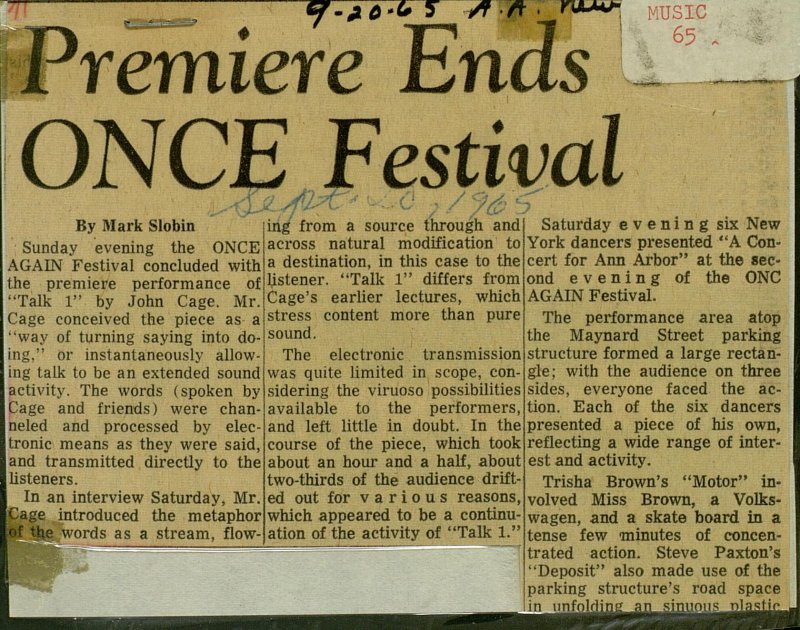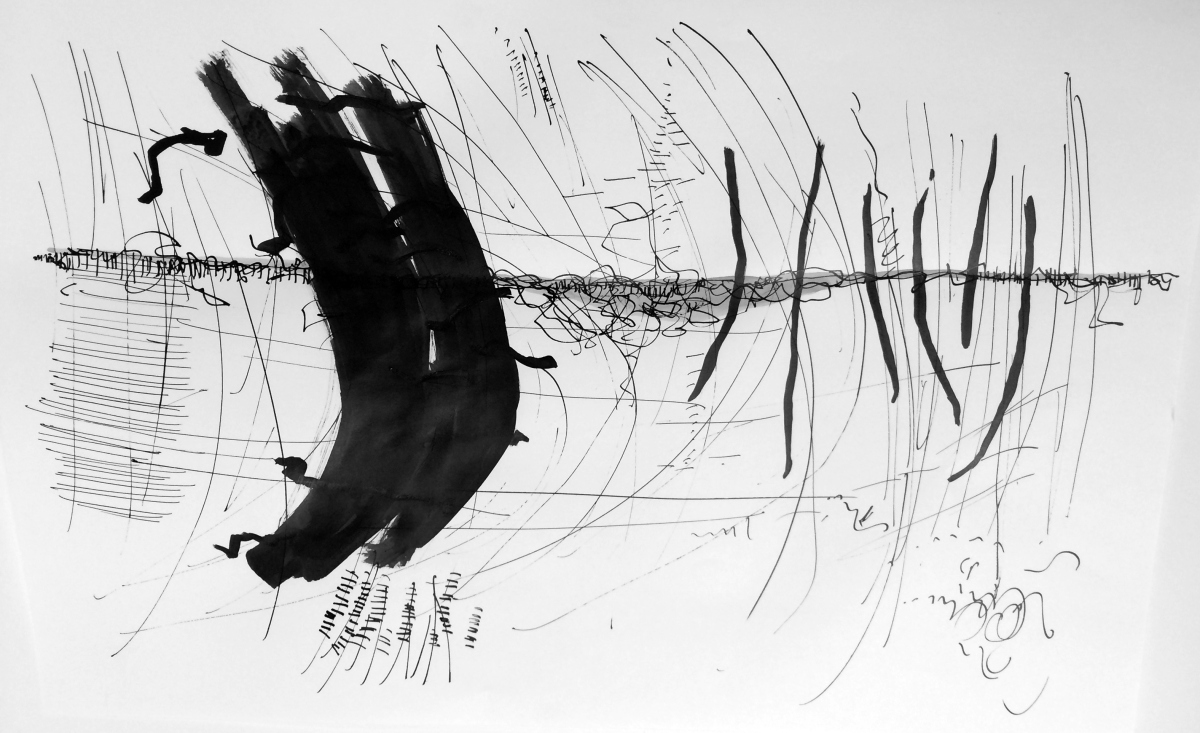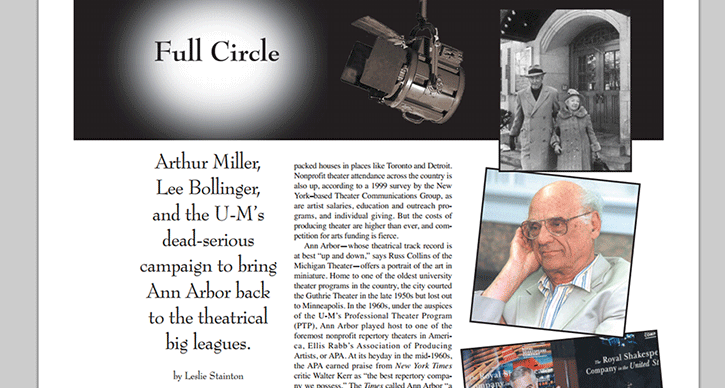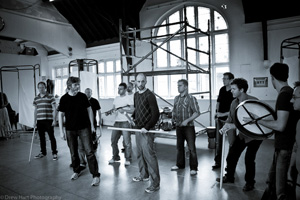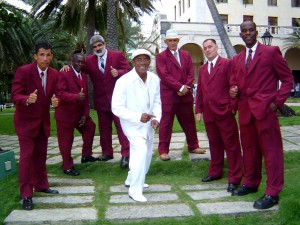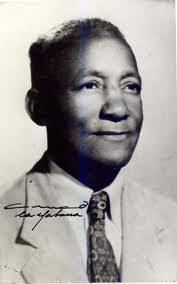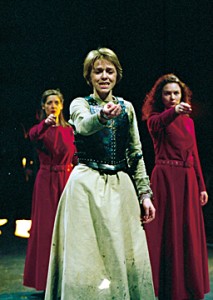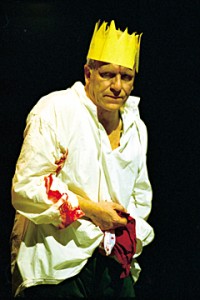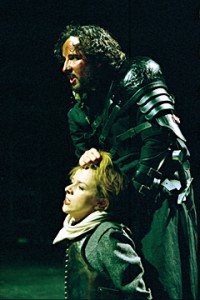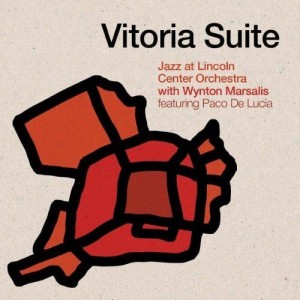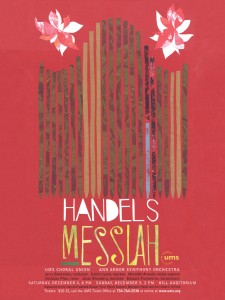March 27, 2018: Your Arts & Culture Adventure Picks
This post is a part of a series of posts curating adventurous arts and culture experiences in Southeast Michigan. Sign up for email updates (choose “Arts & Culture Adventures” list).

UMS Wallace Blogging Fellow Amanda Krugliak is an artist, curator, and arts administrator best known for performance and conceptual experiential installations, most notably as curator at the University of Michigan Institute for the Humanities since 2007.
I’m still patiently waiting for crocuses to be in full bloom, and I’ve been reminded yet again this year that things never quite turn out the way you expected. I’m never going to be an heiress, its official. Alert the media… and I’m not sure I still believe in the American Dream.
But I’ve reminded too, of the power of the People, their great ideas, and how many of them are right here right now. There are so many extraordinary happenings in your town…things to see, places to go, a melody that opens you up. After a long winter and a road full of pot- holes, Place is what you make it. So, turn off the space heater and the nature channel, tumbleweeds are so “yesterday.” Swap those slippers for Chelsea boots, and venture out! Because Why Not….

56th Annual Ann Arbor Film Festival
March 20-25
Ann Arbor
The Ann Arbor Film Festival is truly one of the greatest happenings every year, anywhere. 56 years old, it’s still quirky, smart, engaging, offbeat, inspiring, and inventive. It continues to bring together visual thinkers from across the globe, along with our own eclectic like- minded visionaries, all gloriously gathering in style to celebrate experimental film.
Under the leadership of Director Leslie Raymond and Associate Director of Programs Katie Mc Gowan, the offerings this year surpass expectations in their relevance, and innovation. In addition to the sublime experience of viewing so many wonderful films in competition, and attending all of the celebrations and goings on during the week, the festival offers special new programs this year well worth citing: Memories of Disintegrations: Ibero-American Experimental Film, explores Spanish and Portuguese-language films on Video8, Super *, 16mm, Super 35mm, and VHS. Black Radical Imagination showcases films that explore racial identities beyond the restrictive boundaries and limitations often prescribed to people of color. These challenging programs extend our understanding and reach, and are representative of the bold spirit of this long running avant-garde festival. Also note a special screening of The Big House, a documentary about our own grand stadium and the labor behind the scenes that goes into the sports spectacle…from cooks to snipers. Also this year, don’t miss multi-media works Off the screen in venues across town—among them Lily Baldwin and Peter Rose// Room 2435 North Quad UM, Razan AlSalah and Radical Democracy//Ann Arbor Art Center; and Matt Wilken// Arbor Brewing Company.
TALK: Simone Brown + Danielle Dean in Conversation
March 29, 7 pm
MOCAD, Detroit
Sociologist Simone Browne’s acclaimed book Dark Matters: On Surveillance of Blackness examines surveillance in relation to the history of transatlantic slavery and its afterlives. These themes informed in part by Browne’s research are central to Danielle Dean’s multimedia installation TrueRedRuin on view at MOCAD. This conversation between them explores the different ways that scholarship and artistic practice can overlap, dovetail, igniting critical dialogs and raising social consciousness in the process.
Exercising the Eye: The Gertrude Kasle Collection
 March 10-July 22,
March 10-July 22,
Alfred Taubman Gallery, UMMA, Ann Arbor
This lyrical exhibition celebrates Gertrude Kasle (1917-2016), who was a key figure in the formation of Detroit’s contemporary art community in the 1960’s and 70’s. Like other strong minded maverick women of her generation in the arts, she wanted to provide her Midwestern community with a venue in which to experience cutting edge art from centers like NYC. Yet, she also wanted to support and exhibit regional artists, so that the work of both groups could be included in that visual and critical conversation. This surprising and disarming show, which includes the work of Phillip Guston, Jane Hammond, Robert Rauchenberg, Jasper Johns, among others, captures the particular tenor of that era…the imagination, the drive of the gallerist, and the exciting way artists were connected in their inquiries. Don’t miss the incredible paintings by Grace Hartigan, with superb color and gesture that are as fresh today as in 1974. And make sure to take home a vintage poster from the original shows produced by the Kasle Gallery, which you can purchase in the gift store for a song. Now that’s a great day.
Romare Bearden
N’NAMDI center for contemporary art, Detroit
This exhibition offers an opportunity to see the works of acclaimed artist Romare Bearden, whose collages and paintings are iconic. He has influenced so many young artists who came after in regards to story, directness, use of color, and deliberateness of stroke and design. Bearden was a multidisciplinary artist ahead of the curve, interested in the intersection, influence and overlay of music, visual art, history, performance, literature, and culture. Above all, he was a humanist, genuine in his passion for the world and those in it, past, present and future tied together like a daisy chain.
Like what you read? Sign up for email updates (choose “Arts & Culture Adventures” list).
Why Audra McDonald Loves Ann Arbor
When singer Audra McDonald performed in Ann Arbor in 2011, we asked her what she loves about Ann Arbor audiences. She returns on September 17, 2015.
Tune In Before Select Renegade Performances
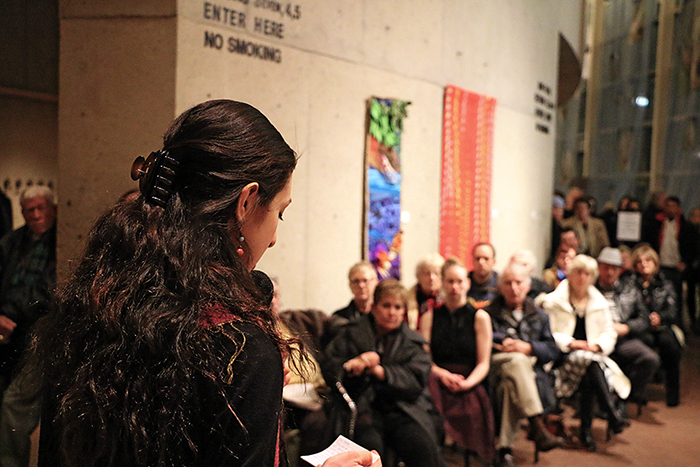 21st Century Artist Intern Hillary Kooistra gives a pre-show Tune In for Trisha Brown Dance Company’s performance February 21, 2015.
21st Century Artist Intern Hillary Kooistra gives a pre-show Tune In for Trisha Brown Dance Company’s performance February 21, 2015.
Tune In with UMS for a brief pre-performance talk before select Renegade series performances; the next Tune In is before Bill Frisell’s solo performance on 3/12. Just 15 minutes long, each Tune In offers interesting information and provocative questions for thinking about, listening to, and watching the performance. The Renegade series celebrates artistic innovation, experimentation, and discovery.
Trisha Brown’s “Motor” at 1965 ONCE Festival
50 years ago choreographer Trisha Brown revved things up with “Motor,” a choreographic work for Volkswagen Beetles that had its world premiere in Ann Arbor’s Maynard Street parking garage. Check out more about this Ann Arbor News clipping: http://bit.ly/1vKHDg0
Did you go see Trisha Brown Dance Company’s performances 2/21-22? What did you think?: http://bit.ly/1A1FhKt
Resident Update: Artist Carolyn Reed Barritt on Compagnie Non Nova
Painter Carolyn Reed Barritt is a UMS Artist in Residence this season. We’ve asked five artists from across disciplines to take “residence” at our performances and to share the work these performances inspire.
Carolyn attended Compagnie Non Nova‘s performance of Afternoon of a Foehn this past weekend at Skyline High School’s black box theatre. She shares her thoughts on the performance:
“I didn’t think I could be so enraptured by ordinary plastic bags…The performance is mastered chaos — each fan controlled to create an airflow which allows the bag puppets to twirl, float and wrestle with each other and their creator in a confined space. Sometimes the puppets skate together along the floor; sometimes it seems as though they are tying to escape by floating up to the ceiling. Sometimes they seem to attack each other. Their creator moves with them, allowing them to dance and fight until they turn on him, using the wind that animates them to envelope and smother him with their bodies, making him so angry he destroys them all. The audio track ebbs and flows from sublime to sinister, the bag puppets go from charming to vindictive, the single, silent actor, ghost-like and imperious — all this in a home-made wind vortex.
If you’re lucky enough to be in Ann Arbor Michigan right now, there are more shows this coming weekend (February 19 – 21, 2015). Otherwise I hope this show comes to you someday!”
Read the full post on Carolyn’s blog
Interested in learning more? Read our interview with Carolyn.
Resident Update: Writer Robert James Russell
Writer Robert James Russell is a UMS Artist in Residence this season. We’ve asked five artists from across disciplines to take “residence” at our performances and to share the work these performances inspire. Robert shares his experiences on dance, music, and his new novel below:
“When I applied for the UMS Artists-in-Residency program, my goal was to see performances and use that inspiration to craft a new novel. I’m beyond thrilled at the chance to experience wonderful performances and explore the role of music and dance in my work—both of which have always been crucial to my mental health, and to my ability to immerse myself in a project.
So far, I’ve seen the following UMS performances, all radically different from one another—and each has inspired me in vastly different ways:
- Ryoji Ikeda (superposition)
- Mariinsky Orchestra
- Compagnie Marie Chouinard
- eighth blackbird
See, this isn’t just writing a novel, coming up with a story and characters, but in this instance I am creating an entirely new place: a fictional island in Lake Superior, documenting the entire history of the island, of the people that lived (and, in the present of my novel, still live) there. Typically when I write I find some style of music that works for that story and I listen to the same record(s) over and over as I write, never growing tire of the repetition. In this instance, though, since it’s not just story, but history…and this immersion in different types of performances has been utterly liberating:
- superposition taught me, even through the wondrous noise, about the use of silence in my work.
- The Mariinsky Orchestra inspired me to embrace more bombastic/dramatic sections of the story.
- Watching the Compagnie Marie Chouinard showed me how to re-think interactions of characters, how they meet in the story, but also how these characters interact with the island itself.
- eighth blackbird encouraged me to embrace the unexpected—to travel different routes in the storytelling, in the creation of the island’s history, of its inhabitants, and to avoid the predictable…to really dig deep and do something unique.
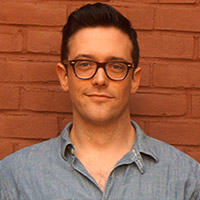 Each of these performances has taught me re-think what I know about art and inspiration, and they are with me every day when I write. In addition to a seemingly never-ending list of books I flip through daily—various back-issues of National Geographic featuring articles about Isle Royale (used as inspiration); a 1937 manual called Wolf and Coyote Trapping; the unbelievably inspiring/gorgeous Atlas of Remote Islands by Judith Schalansky; others—I am constantly harkening back to each performance, remembering them, and making sure that they are not forgotten. And I am reminded with every word I put down how astonishing and remarkable the performing arts are…how important they are to the production of any art.”
Each of these performances has taught me re-think what I know about art and inspiration, and they are with me every day when I write. In addition to a seemingly never-ending list of books I flip through daily—various back-issues of National Geographic featuring articles about Isle Royale (used as inspiration); a 1937 manual called Wolf and Coyote Trapping; the unbelievably inspiring/gorgeous Atlas of Remote Islands by Judith Schalansky; others—I am constantly harkening back to each performance, remembering them, and making sure that they are not forgotten. And I am reminded with every word I put down how astonishing and remarkable the performing arts are…how important they are to the production of any art.”
——
Robert James Russell is the author of two upcoming books: the collection Don’t Ask Me to Spell It Out (WhiskeyPaper Press, 2015) and the novel Mesilla (Dock Street Press, 2015). His first novel, Sea of Trees, was published in 2012. He is the founding editor of the literary journals Midwestern Gothic and CHEAP POP. You can find him online at robertjamesrussell.com and @robhollywood.”
Interested in learning more? Read our interview with Robert.
Resident Update: Painter Carolyn Reed Barritt on Compagnie Marie Chouinard + Mariinsky Orchestra
Painter Carolyn Reed Barritt is a UMS Artist in Residence this season. We’ve asked five artists from across disciplines to take “residence” at our performances and to share the work these performances inspire.
Carolyn attended Compagnie Marie Chouinard on January 23rd, and Mariinsky Orchestra on January 25th, 2015. She shares her thoughts on both performances:
“M
arie Chouinard’s Gymnopedies begins languidly, with the dancers emerging nymph-like and naked from canvas pods, then morphs into a seemingly non-stop riot of movement and role playing that was sometimes so sexy it was almost uncomfortable and sometimes so childishly silly that the audience didn’t quite know whether or not to laugh. The Henri Michaux piece brought movement up to another hyper level and was reminiscent of a dance contest gone too far. The dancers, mimicking the projected ink blots of Michaux’s Mouvements, expressed the drawings in broken, jagged lines, with an awkward jerkiness that was softened with a fluid, serpentine beauty.”
On Mariinksy:
“Before entering the hall for Mariinsky, I was given a flyer by a person protesting the orchestra. Last weekend I read the New York Times’ interview with Gergiev. I know a little about the situation in Ukraine, but don’t know as much as I should. Reading neither the flyer or the Times interview really enlightened me as to Gergiev’s personal views or the views of anyone in the orchestra. But what I have heard and read about Ukraine was in my mind at the concert and I’m sure it tainted my experience that afternoon.”
Read the full post on Carolyn’s blog
Interested in learning more? Read our interview with Carolyn.
The State of Theater in Ann Arbor: Looking Back to 2000, and Looking Ahead
Editor’s note: This article initially appeared in the Ann Arbor Observer in October 2000 and offers a snapshot of the history of theater in Ann Arbor and major developments in the city’s theater life during this time.
Leslie Stainton is a regular contributor to UMS Lobby, focusing on theater. Her new book Staging Ground captures the history of one of America’s oldest and most ghosted theaters—the Fulton Theatre in Lancaster, Pennsylvania.
She participates in an authors panel on January 28, 2015, which also included U-M faculty Martin Walsh and Leigh Woods. While the panel will spotlight Staging Ground, it will also provide an updated look at the state of theater in Ann Arbor today.
We thought this “time capsule” would be a great read ahead of that panel.
Arthur Miller, Lee Bollinger, and the U-M’s dead-serious campaign to bring Ann Arbor back to the theatrical big leagues.
It’s been nearly sixty-five years since Arthur Miller sat in a rented room at 411 North State Street in Ann Arbor and in six days wrote his first play. That work, No Villain, won Miller a Hopwood Award worth $250—half the sum it had cost him to come to Michigan in the first place—and convinced him he had what it took to compete with the reigning Broadway playwrights of his day: people like Clifford Odets, Maxwell Anderson, and Philip Barry.
Today, of course, Miller’s name outshines all the rest. “He’s the greatest living American playwright,” says U-M English prof Enoch Brater. With Eugene O’Neill and Tennessee Williams, Miller created the plays that became the bedrock of American theater. His best-known work, Death of a Salesman, has been performed around the world. Last year’s Broadway revival won four Tony Awards half a century after the play premiered in 1949.
Arthur Miller returns to Ann Arbor this month to give the keynote address at an international symposium honoring him on his eighty-fifth birthday. It’s an auspicious moment in the American theater, nationally as well as locally.
An Up and Down Track Record in Ann Arbor
From New York to California, the commercial stage is thriving. For the first time in years, thanks to a booming economy, every theater on both Broadway and Off Broadway is lit. Big musicals earn huge grosses in New York and spawn profitable touring productions that play to packed houses in places like Toronto and Detroit. Nonprofit theater attendance across the country is also up, according to a 1999 survey by the New York–based Theater Communications Group, as are artist salaries, education and outreach programs, and individual giving. But the costs of producing theater are higher than ever, and competition for arts funding is fierce.
Ann Arbor—whose theatrical track record is at best “up and down,” says Russ Collins of the Michigan Theater—offers a portrait of the art in miniature. Home to one of the oldest university theater programs in the country, the city courted the Guthrie Theater in the late 1950s but lost out to Minneapolis. In the 1960s, under the auspices of the U-M’s Professional Theater Program (PTP), Ann Arbor played host to one of the foremost nonprofit repertory theaters in America, Ellis Rabb’s Association of Producing Artists, or APA. At its heyday in the mid-1960s, the APA earned praise from New York Times critic Walter Kerr as “the best repertory company we possess.” The Times called Ann Arbor “a major regional theater center.”
Since then, it’s been a roller-coaster ride. By 1970 the APA had largely dissolved. The PTP continued to bring in touring shows from the likes of Ontario’s Stratford Festival and John Houseman’s Acting Company, but its visionary co-directors, husband and wife Robert Schnitzer and Marcella Cisney, retired shortly after the construction of the Power Center for the Performing Arts in 1971. In 1973 the PTP was merged into the U-M theater department and placed under the direction of the department chair, a move that further weakened the once maverick organization. “It never got back on its feet again, which is heartbreaking,” says longtime producer, performer, and Ann Arbor theater patron Judy Dow Rumelhart.
Rumelhart herself was involved in a brief attempt to create an outdoor Greek theater festival in Ypsilanti in the late 1960s. The theater’s first and only season starred Ruby Dee, Dame Judith Anderson, and Bert Lahr. But fragile community support, poor leadership, and a deteriorating economic climate doomed the effort.
In the late 1970s Ann Arbor theater aficionado Jim Packard spearheaded an ambitious town-gown endeavor to organize a summer performing arts festival on the scale of Stratford. “I believe it is the manifest destiny of Ann Arbor to become the cultural capital of the region,” Packard said at the time.
But despite an elaborate, two-year planning process that included detailed marketing and feasibility studies, consultations with nonprofit theater professionals throughout the country, and grants from the National Endowment for the Arts and the National Endowment for the Humanities, among others, the project foundered—partly because of turf wars between the city and the university, partly because of a statewide recession, and partly because the university was not prepared to market the endeavor on the scale it required. From the spoils of the project, today’s much smaller Ann Arbor Summer Festival emerged.
Twice in the 1980s the U-M tried to establish professional companies in alliance with its theater department, but both efforts—Walter Eysselinck’s Michigan Ensemble Theater and John Russell Brown’s Project Theater—folded after a few seasons. In each case, the department chair was simultaneously artistic director of the professional company, in an arrangement that had already proved unworkable in the early 1970s.
In 1991 Hollywood actor Jeff Daniels opened the Purple Rose Theater in his hometown, Chelsea. In 1996 Ann Arbor’s Performance Network went professional. Both companies are opening new theaters this season, a mark of their prosperity (see sidebar, “Reversals of Fortune”).
But Purple Rose and Performance Network are small companies that present exclusively new plays on modest budgets. Ann Arbor continues to lack the kind of first-rate anchor that a large-budget, nationally visible theater such as the Guthrie in Minneapolis provides.
In a now legendary irony, Sir Tyrone Guthrie toyed with putting his theater in Ann Arbor in the late 1950s but ultimately chose Minneapolis because of its more lucrative business climate. U-M administrators gave Guthrie an initially “cool reception,” remembers Wilfred Kaplan, who was involved in the effort to lure Guthrie to Ann Arbor. That, coupled with a lukewarm response from the Detroit business community, steered Guthrie away from Michigan. “Everyone had to come together, and they didn’t,” Kaplan recalls.
Theater: The Weak Sister
Today, Ann Arbor’s theater scene doesn’t begin to approach its musical and dance offerings in either quality or quantity. In a town that routinely sees the likes of the Berlin Philharmonic, Yo Yo Ma, Mark Morris, and the Martha Graham Company, theater is “the weak sister,” says Russ Collins. Collins attributes the situation to Ann Arbor’s German-immigrant heritage. “Music is strong because the Germans valued it. These social patterns hold sway even when the ethnic relevance has gone away.”
For U-M president Lee Bollinger, theater is the missing link in Ann Arbor’s otherwise rich cultural picture. “We should have theater that is as vibrant as the music that we experience on campus,” he says. A passionate advocate of the arts who carries a copy of Shakespeare with him much of the time and tries to read something from it “almost every day,” Bollinger has put theater at the center of his vision for the university. In fact, the former law professor and dean is the one person with both the imagination and the means to change not only the university’s but Ann Arbor’s theatrical fortunes in a big way, and he seems determined to do it.
At a press conference last spring, Bollinger announced plans to build a Walgreen Drama Center near the Power Center, on the university’s Central Campus. The new complex will include two theaters: a 600-seat Arthur Miller Theater and an as yet unnamed 100-seat space.
During the same press conference, University Musical Society president Ken Fischer announced the launch of the first full-fledged theater season in the organization’s 122-year history. The season, which opens this month, will include appearances by the Gate Theater of Dublin, Harvard University’s American Repertory Theater, and a three-week residency by one of the world’s foremost classical theater companies, the Royal Shakespeare Company. The season ends next April with a performance piece that UMS has co-commissioned with composer Benjamin Bagby and theater director and visual artist Ping Chong.
A Look at the RSC Residency
By far the largest, most expensive, and riskiest component of the UMS theater season is the RSC residency. “It’s the biggest thing we have ever done. Ever,” says Fischer. RSC is presenting all eight Shakespeare history plays in chronological order in a single year, an “extraordinary dramatic marathon,” in the words of the New York Times, that’s rarely been tried on any stage. The company will present four of those productions at the Power Center next March. In addition to paying the staggering cost of transporting a company of fifty-three (thirty actors and a crew of twenty-three) to Ann Arbor for three weeks, UMS is contributing significantly to the cost of producing the series, which will open in its entirety in Stratford, England, move to London, and conclude in abbreviated form in Ann Arbor. No other foreign tour is planned.
The transatlantic partnership that has evolved between the two groups is unique, according to Barbara Grove, RSC’s American representative: “It goes much beyond a tour. This has turned into a prototype.” Under the terms of its agreement, RSC will visit Ann Arbor at least two more times in the next five years and will make UMS its premier university partner in the United States.
The company itself “honestly contends they could not have done this cycle as they’re doing it without the University of Michigan,” Grove says. As a measure of its respect, RSC recently invited Bollinger to serve on its American board of directors.
Bollinger realizes that many in the community find his interest in theater surprising. “One of the great things about being university president,” he admits, “is that people have such low expectations of your cultural interests.”
If UMS is unable to raise its $2.5 million share of support for the RSC project, Bollinger has guaranteed that the university will make up the shortfall. In addition, he has already assembled most of the $20 million it will take to build the Walgreen Drama Center. Michigan alumnus Charles Walgreen Jr. has contributed between $11 and $12 million to the project, and Bollinger will use an undesignated bequest to the university to cover most of the rest.
Arthur Miller Theater
He is especially eager to build the Arthur Miller Theater. While some believe the university is moving too fast on the project—“I believe they should have [first] built an entire theater department, an Arthur Miller School of Theater,” says Rumelhart—Bollinger contends that it’s time the university honored its link to one of the most enduring voices in American, and indeed world, culture. “This is what you hold up to the students—that one of the greatest playwrights of the twentieth century found his talents here,” the president says.
When he first pitched the idea of an Arthur Miller Theater to Miller himself, the playwright sent back a note that now sits, framed, in Bollinger’s office. “The theater is a lovely idea. I’ve resisted similar proposals from others but it seems right from Ann Arbor,” Miller wrote.
The question now is whether Bollinger’s commitment portends a new golden age for theater in Ann Arbor—or whether this is just another bump in the roller coaster.
In Arthur Miller’s heyday, the great playwrights of the age were all seen on Broadway. Production costs and ticket prices for New York and major touring shows weren’t as prohibitive as they are now, and the theater was part and parcel of middle-class life and culture. Certain plays—Death of a Salesman among them—became part of the nation’s collective consciousness.
That happens far less frequently today—“which doesn’t mean the theater is in a bad state,” suggests Enoch Brater, who is organizing this month’s Arthur Miller symposium and will be a key participant in the Musical Society’s theater outreach programs. It does mean, though, that the old rules don’t apply. Theater—especially theater in a digitized, cable-ready twenty-first century—must reinvent itself, as it has countless times in its history, if it is to be anything but a quaintly anachronistic pastime.
Why do people go to the theater, anyhow?
Why do people go to the theater, anyhow? Simply to be entertained? To be sociable? To learn something? Or does live theatrical performance continue to meet some fundamental human need that no other medium can approach?
Obviously, those who have devoted themselves to the art think it does. Broughton believes “the more time we spend in front of these TV monitors, the more we want live entertainment. Theater lets you interact.”
“The more inundated people are with technology that’s been manipulated and studied to appeal to a preconceived notion of what audiences want, the more valuable live performance is,” maintains UMS’s [Director of Programming] Michael Kondziolka. “We program against that culture. And guess what? People are hungry for it. People are coming in record numbers to our programs, which are decidedly non–market driven—if by ‘market driven’ you mean tested and focus-grouped and surveyed and preresearched.”
At Chelsea’s Purple Rose, selling live theater to young audiences, in particular, is “a survival issue,” says artistic director Guy Sanville. “Tomorrow’s audiences are found in today’s classrooms.” What’s more, Sanville contends, theater is “a healing alternative to a chemical high. Arts and music are the drugs of choice for millions of kids.”
At its most basic level, a volunteer theater like the Ann Arbor Civic serves much the same social function as a church—it’s a gathering place for the community. Although he does not want the university’s multimillion-dollar Arthur Miller Theater to serve exclusively as a community theater, Lee Bollinger has said he is “open” to both community and student use of the space. He does not intend to place it under the control of either the theater department or the School of Music, however. Bollinger’s vision is larger than that. He’s convened a universitywide committee to consider plans for the new complex, as well as a trio of informal advisors: Broadway producer Robert Whitehead, Purple Rose founder Jeff Daniels, and Jack O’Brien, a Michigan alumnus who is artistic director of the Old Globe Theater in San Diego.
Bollinger concedes that he’s not yet sure what will go into either the Miller Theater or the Walgreen Drama Center once they’re built. He wants the complex to be a place for the creation of new work. He’ll seek an endowment to fund national and international collaborations with professional companies and a playwright-in-residence program. He’s toying with the idea of finding an artistic director to oversee “major alliances, new-play programs,” and the like. He is “open to thinking about UMS running it.”
He acknowledges that what’s missing from the Ann Arbor theater scene is professional theater of the very highest caliber. But he is admittedly vague about how he would address that deficiency, or whether he even wants to. He’s not sure whether the new Miller Theater should be strictly a presenting house for shows developed elsewhere or should occasionally produce its own plays.
Bollinger hopes to choose an architect by the end of this month. Construction of the new complex is expected to take several years. In the meantime, performing-arts organizations as disparate as UMS, Performance Network, the Ann Arbor Civic Theater, and University Productions, which manages most of the other stage spaces on the U-M campus, are watching developments closely.
A continuing commitment
One thing is clear: although Lee Bollinger’s determination is sufficient to build an Arthur Miller Theater, a continuing commitment will be needed if it is truly to live up to its name.
“Ann Arbor could have as rich a theatrical life as it does music if the University of Michigan, or some other group of subsidizers, will invest for ten years,” Russ Collins believes. “Theater has been strongly supported here in the past, but then debt and ambivalence set in, and it goes away. There needs to be a commitment of a significant period of time.”
Mark Lamos, former artistic director of the Hartford Stage Company in Connecticut and an adjunct professor in the U-M theater department, goes farther: “For a community such as Ann Arbor to support professional theater at the highest level, you need a group of people who believe in it so strongly they will be willing to fund-raise ceaselessly, choose and support artistic and management leaders, and be standard-bearers within the community for the institution. Every great regional theater began as a dream of pillars of the community.”
Such a theater, Lamos continues, also requires “large corporate pockets, large personal ones,” and an audience “that will sustain and support a variety of theatrical productions. An audience for an institution must be developed not through a hit-and-flop mentality but through a newly discovered conviction that the institution itself is more important than any one show—that its artistic mission is worth subscribing to.”
Finding and maintaining such support isn’t easy. Lamos left Hartford Stage in 1997, after seventeen seasons at its helm, because he’d grown tired of the ceaseless struggle for money. “Corporations were merging or downsizing, and the same group of wealthy arts devotees were being pursued by hospitals, universities, the symphony, the ballet, the museum. The community became too small to support my visions of artistic growth and institutional expansion.” Ann Arbor, he points out, is even smaller than Hartford.
It’s unclear, too, how a town the size of Ann Arbor, a four-hour drive from Chicago, the nearest major theatrical center, can attract the country’s finest actors, directors, and designers. Unlike musicians, who can fly in and out of a city in a matter of days or even hours to give a concert, theater artists typically need weeks of ensemble rehearsal to mount a production. Why spend that time in Ann Arbor?
Why spend time in Ann Arbor?
“We have to think about what could happen in Ann Arbor, in regard to theater, that could not happen in New York, Chicago, or London,” says Enoch Brater. “What can we allow theater professionals who are based there to do here that they can’t do there?”
Brater believes the university is the answer. In the absence of significant federal support, he maintains, universities today “are the great patrons of the arts. We can’t rely on Congress anymore. And it’s unrealistic to rely only on private support.”
It’s a vision Lee Bollinger shares—and he’s even writing a book on the subject. Last year Bollinger quietly provided $10,000 in university funds so that, under the auspices of UMS, singer Jessye Norman and choreographer Bill T. Jones could spend a week on campus working, in private, on a project they ultimately premiered in New York as part of the Lincoln Center Great Performances series. According to Ken Fischer, both artists reported afterward that they accomplished more “in one week in Ann Arbor than they could have in three months in New York.”
As Bollinger, Fischer, and their collaborators launch their new theater initiative, they can draw both inspiration and caution from the U-M’s own history. Back in the 1960s, generous university support enabled Ellis Rabb and his APA to develop productions in Ann Arbor that the company then took to New York. At the same time the Professional Theater Program, which brought the APA and other companies to campus in the 1960s, operated with little university control, as UMS does now.
Back in 1961, when university administrators invited Robert Schnitzer and Marcella Cisney to move to Ann Arbor from New York to run the PTP, they offered to build the couple a new theater. The pair turned it down. Writing about that gesture in a 1970 article for Players: The Magazine of the American Theater, journalist Glenn Loney observed, “The American Way is to build a theater in haste and then try to find out how to use it somehow, at leisure. [Schnitzer and Cisney] understood what few other artistic teams have: that you must first find out who your audience is, where it is, what it wants, what it needs—not always the same thing—and what varieties of creativity and service you can hope to present.”
Paradoxically, after Schnitzer and Cisney finally agreed to a new theater, and not long after the university built the Power Center, the couple left town. “It was retirement time, darling,” recalls Schnitzer, who, at age ninety-four, now lives in Connecticut. “I felt I’d paid my dues. It was a strenuous business, that dozen years. We worked like dogs.”
Schnitzer and Cisney were certainly entitled to their retirement, but without their leadership the PTP drifted and soon faded away. What’s to prevent history from repeating itself with the Arthur Miller Theater?
An Audience Ten Years Later
By September UMS had already sold over 1,000 complete RSC cycle tickets, and Fischer and Kondziolka are optimistic that the momentum can be sustained in subsequent seasons. “We think the time is right,” Kondziolka says. “We can help support the university by starting the labor-intensive, difficult work of building an audience, reestablishing a community, so that by the time the Arthur Miller Theater opens its doors there will be an audience ready, willing, and excited to accept this gift.”
That would be a tremendous accomplishment, and an essential prelude to the creation of a successful new theater. But will the Arthur Miller Theater continue to thrive ten or fifteen years down the road, once the novelty of the idea has worn off? Will a 600-seat theater be sufficient to offset the costs of producing or presenting world-class work, especially in a post-Bollinger administration whose focus is likely to be elsewhere? Will community leaders be willing, as Mark Lamos alleges they must, to “do anything on earth—including mortgage their homes” to keep the theater alive? Or was Tyrone Guthrie right when he decided that Ann Arbor couldn’t support the level of theater he had in mind?
At the outset, of course, the ball is in Bollinger’s court. It bodes well that the president himself is passionately excited by the prospect of bringing topflight theater to Ann Arbor. Shortly after Bollinger announced his plans for the building, Russ Collins sent him a note saying he hoped that Bollinger would listen “to his own inspiration and vision on this. It’s going to take that kind of leadership.”
There’s one other piece of advice that Bollinger would be especially wise to heed. It comes from Miller himself, who after all has chosen Ann Arbor as the one city to have a theater bearing his name. When the playwright learned last May that the regents had approved the Arthur Miller Theater, he wrote to Bollinger, “Who would have believed back in 1932–1934 when I was saving $500 to go to Michigan that it would come to this? Now to mount some memorable productions!”
Don’t miss the authors panel on January 28, 2015 at the Ann Arbor District Library, which includes Leslie Stainton as well as U-M faculty Martin Walsh and Leigh Woods. Moderated by UMS Director of Education & Community Engagement Jim Leiha. The panel will spotlight Staging Ground and also provide an updated look at the state of theater in Ann Arbor today.
Letters from Artists: David Finckel, for the Emerson String Quartet
 All one has to do for the Emerson String Quartet is mention “Ann Arbor,” and vivid images arise, as we have been playing regularly for the University Musical Society since our earliest days. To a large extent, the places to which we have returned many times during our career are part of who and what we are.
All one has to do for the Emerson String Quartet is mention “Ann Arbor,” and vivid images arise, as we have been playing regularly for the University Musical Society since our earliest days. To a large extent, the places to which we have returned many times during our career are part of who and what we are.
From the Detroit Airport to the stage of Rackham Auditorium is a route as familiar as from my living to dining room: lunch at my favorite Lebanese restaurant near the airport; I-94 to the Ann Arbor exit; squeezing in the little tunnel under the hall; parking in the restricted space; the long tunnel to the double-sided green room, where tables are laden with photos to sign and the always-mind-blowing UMS season brochures; the little bells that count down to the concert; ascending the slightly-treacherous staircase to the left; squeezing through the small stage entrance while a stage attendant opens and disappears behind the door; and finally, the familiar warm welcome and intense listening of the discriminating and devoted UMS audience, ready to hear even our most challenging programs, and always rewarding us with hearty thanks.
The equally important part of the Ann Arbor experience is, of course, encountering director Ken Fischer, who seems ever more youthful in years and inspired in vision. To be a part of what UMS creates in Ann Arbor is, for us, to be part of something vastly larger than ourselves, which is seen around the country as an incomparable model of presenting and community service. With its strong and clear mission, UMS should be around for a good long time, here to serve the children and grandchildren of the vibrant Ann Arbor community. We wish Ken and his always-stellar team as much success as they can imagine, and more.
 David Finckel is the cellist for the Emerson String Quartet.
David Finckel is the cellist for the Emerson String Quartet.
In Closing, An Open Letter to Propeller Theater Company
I will be frank with you: I was hoping to have my world rocked when I walked into your shows this week. I’d heard so much about you, lectures and my brother and my professor and the you tube trailers and the information on the UMS website. You seemed like just the type of company for me. And let me tell you, you fulfilled all of my twenty-two-year-old drama-English-music-geek dreams. You are a company of talented, passionate, dedicated, vocally gifted, really good looking men who make Shakespeare into something brand new while somehow getting closer to the root and core of the text than any production I’ve ever seen.
In short, I wanted my world to be rocked. And rocked it was.
But, see, I’m not all that important. And it’s not because I’m young. It’s not because I’m not a big theater critic, or I’m not some CEO who can fund you. God willing, one day I’ll have the swag to fund the arts the way I think they should be funded. I’m unimportant because you didn’t have to win me over. I already love Shakespeare.
What makes YOU really important Propeller, is not that I, a lover, was rocked. What makes you important is that all the people who are lukewarm about Shakespeare, or don’t know Shakespeare, or who just downright don’t LIKE Shakespeare, are suddenly curious.
I’ve rarely seen an Ann Arbor audience so receptive to pure slapstick and tomfoolery. We’re a stuffy liberal town generally, mixed in with the conservative elements from the surrounding areas who come in for the shows and the restaurants. But there they all sat, two older women in front of me enjoying the performance just as much as I was, as much as my mother (in from the suburbs of Detroit) was, as much as the two women who were sitting next to me speaking in French during the intermission, as much as the younger men with their dates in the front row who got pulled into the action.
Oh I’m sure some people walked out in the middle of the performances insulted, or rolled their eyes, or thought the naked man with a sparkler up his rear was just tasteless. But those, I think, were much fewer and farther between than those of us who absolutely loved what you were doing up on that stage.
Because really, it’s not everyone who can take a piece of history and make it live again. It’s not every company that can keep an audience so riveted that they watch you perform in the lobby at intermission as well as on the stage for two hours. It’s not just anybody who can take a play centuries old and plant it in our heads like it just happened, like we just heard this news, this story, today.
I already love Shakespeare, and it was obvious when I watched the shows you presented. But what was really extraordinary was that I didn’t feel alone in my unashamed and vocal enjoyment of the show. I felt, for one of the very few times in my life as an audience member, as essential to the show as the company was. And as much a part of the group of the audience, as you are Propeller, within your incredibly close knit company.
There are few things more beautiful than watching people around me discover Shakespeare. My own aunts were asking me their questions at intermission and pronounced the production “wild,” at the close, wishing they had been able to see Richard as well.
Which is exactly as it should be Propeller – they should all want more when they leave. Like any brilliant piece of art, they should still be thinking, feeling, reacting, after they walk out the door. It should stick with them. Haunt them like Richard, make them smile like Comedy, explore some part of their humanity like Shakespeare always always does. Anyone who sees this production is thinking, Propeller, where have you been all my life, for I ne’er saw true Shakespeare till this night!?
And that is simply beautiful. There will always be Shakespeare lovers like me. But many of those people who saw you this week will be thinking about Shakespeare in an entirely new way. That is something incredible.
So, my dear Propeller, take this as a open invitation from Ann Arbor. We send our love, our appreciation, and above all our gratitude. A good theater company is hard to find, but you certainly fit the bill. It was an absolute pleasure to have you. Now, come back soon, hear?
Sincerely,
Jen Leija (blogger and adamant fan)
Alberto Nacif on Septeto Nacional de Cuba
Of the many great Cuban musicians and orchestras to grace our stages, one that I thought I would never see is coming to Ann Arbor on Thursday, April 7th!
The Septeto Nacional de Cuba, which was founded in 1927 by Ignacio Pineiro (1888–1969), contrabass player, singer, and composer will perform the real Cuban son, the music of the Cuban countryside that took over dance halls and clubs alike in the early 1930s. This music, which is the true progenitor of Salsa and is still popular in both urban and rural settings, originated in Oriente, a province 600 miles from Havana and was a combination of African-derived instruments with Spanish verse forms and stringed instruments. The son has syncopated rhythms and catchy melodies and harmonies which make this a music to sing and dance to.
The music of Pineiro has become a part of the vocabulary of Cuban music, played lovingly by so many of the great musicians, past and present, Cuban and non-Cuban, and still fresh and vital 80 years later. The late 1920s were witness to an explosion of trios, quartets, sextets, and septets from different parts of Cuba each exploring the son, each competing for the pinnacle of expression. Pineiro named his septet “Septeto Nacional” because of the representation of musicians from all over Cuba, and quickly rose to be one of the most successful, thanks again to Pineiro’s compositions and the Septeto’s musicianship. It is no wonder then that so many young musicians are still drawn to this sublime style of music that has maintained its sepia-tone warmth along with Kodacolor excitement.
This concert will be this legendary and much-revered group’s first visit to Ann Arbor, a younger generation of young masters to bring the magic and fire of the Cuban son.
Don’t miss this!!!!
UMS to Donate Proceeds from Bach Collegium Japan Concert to Earthquake Relief
The University Musical Society will donate 50% of all new ticket purchases to the Bach Collegium Japan concert on Thursday, March 24 in Hill Auditorium to the American Red Cross Japan Earthquake and Pacific Tsunami Relief fund.
Bach Collegium Japan and its conductor Masaaki Suzuki arrived in the United States on Monday for a five-concert tour of Bach’s Mass in b minor, which will be performed in Hill Auditorium on Thursday, March 24 at 8 pm. The group is the third Japanese ensemble presented on the UMS program this season.
Officials from the Bach Collegium Japan identified the American Red Cross as the fund that they would like to support. UMS will track all ticket sales from March 16-24 for the Bach Collegium concert and donate 50% of the ticket price to the American Red Cross Japan Earthquake and Pacific Tsunami Relief fund.
“Our hearts go out to everyone in Japan and locally who is dealing with the aftermath of this terrible tragedy. We have seen first-hand the incredible healing power of music. Nevertheless, we also wanted to do something concrete to signal our support for the many Japanese artists whom we’ve presented over the years,” said UMS President Kenneth C. Fischer.
Masaaki Suzuki, the ensemble’s music director, said, “This has been a very difficult time for my country. We are extraordinarily grateful to all of those in the United States who are offering their support.”
Half of the cost of every ticket purchased between now and the concert on March 24 will automatically be designated for the earthquake relief fund. For further information, contact the UMS Ticket Office at 734-764-2538 or www.ums.org.
This Day in UMS History: Royal Shakespeare Company History Plays (March 10-18, 2001)
Ten years ago today, UMS audiences began a great experiment — the Royal Shakespeare Company presenting four Shakespeare History plays (Henry VI, parts i, ii, and iii, and Richard III) over the course of 27 hours with lunch and dinner breaks built in. The productions, directed by now-RSC artistic director Michael Boyd, marked the beginning of a long relationship between the University of Michigan and Ann Arbor with the RSC. Over the past decade, this partnership has included three major residencies, as well as workshopping new plays on the U-M campus. Each residency was accompanied by dozens of free educational events for students and the public-at-large.
Those who were present will no doubt fondly recall some of these images from the productions:
The three Henry VI plays were presented at 11 am, 2 pm, and 8 pm on a Saturday, with audiences returning on Sunday for the climactic production of Richard III. (There was also one mid-week cycle, which ran Tuesday, Wednesday [both matinee and evening], and Thursday.) Since that season, UMS’s theater programming has expanded significantly, with an annual commitment to presenting both live and high-definition broadcasts of international theater — including this season’s productions of Richard III and The Comedy of Errors by another British theater company, Propeller. Like the RSC, Propeller presents contemporary interpretations of Shakespeare and works with an ensemble cast; unlike the RSC, Propeller uses an all-male cast to present the Bard’s works, as would have been the case in Shakespeare’s day.
Richard III opens at the Power Center on Wednesday, March 30, and The Comedy of Errors opens the following evening. Tickets can be purchased at www.ums.org or by calling 734-764-2538.
VIDEO: Connecting Artists and Kids Through UMS Youth Performances
During a two week period (that began on Friday) UMS hosts five “youth performances” — performances by mainstage artists held during the school day and attended by kids ranging from ages 5-18 from throughout southeastern Michigan. In December, the Carolina Chocolate Drops gave a youth performance to a full house of kids the same day as their sold-out public performance, teaching songs and sounds, as well as performing music. The atmosphere was electric. At the public performance, the CCD talked about how committed they are to providing educational experiences for youngsters and how much they enjoyed performing for the kids earlier in the day. In this video, some students from a local elementary school in Ann Arbor talk about what they enjoyed most about the performance.
Although they only last an hour, these youth performances take literally dozens of people and hundreds of person-hours to pull off. For each performance, UMS creates a “teacher resource guide” that provides background information for teachers, as well as activities they can conduct with students in the classroom. Dozens of Advisory Committee volunteers serve as ushers and provide logistical support for getting all of the students in and out of the venue in a timely fashion. And, of course, backstage the production staff is working with the artists to ensure a top-notch performance. UMS Youth Education Manager Omari Rush is at the center of it all, creating the teacher resource guides, communicating with teachers, ushers, production staff, and following up with those in attendance to ensure an optimal experience.
Recent performances include Brazilian dance, a Native American songwriter, a salsa band, and high school students performing classical music:
Grupo Corpo — Friday, January 21
Joanne Shenandoah — Monday, January 24
Baby Loves Salsa — two performances on Monday, January 31
Sphinx Competition — Friday, February 4
UMS Youth Performances are just one component of a well-rounded youth education program that also includes teacher “cultural literacy” workshops; culture-focused book clubs; day-long intensive “immersions” that focus on a specific culture, community, or art form; and training with education experts provided as part of UMS’s relationship with the Kennedy Center Partners in Education program, which provides educators with arts-infused strategies to enhance student learning across various areas of the curriculum. Click here for complete details on all youth education programs.
UMS Offers One-Day Sale for Wynton Marsalis Tickets on Weds, Jan 19
UMS jazz lovers are in luck — on Wednesday, January 19, UMS will offer special pricing for Wynton Marsalis’s upcoming concert on Wednesday, February 2 at 8 pm with the Jazz at Lincoln Center Orchestra. The offer is being made to celebrate the designation of Wynton Marsalis — and the entire Marsalis Family — as an NEA Jazz Master.
All remaining main floor seats will be sold for $35, and all mezzanine seats for $25 — a savings of up to 43%!
This year’s concert features music from the Jazz at Lincoln Center’s latest release, Vitoria Suite. Vitoria Suite is a new extended work by Marsalis that uses the impulse of the blues as a foundation to jointly explore the music of two worlds and two cultures: the jazz and blues of North America and the indigenous music of the Basque region and flamenco of Spain. The world-renowned big band also performs original compositions and newly-arranged music of Chick Corea.
To purchase tickets, call or visit the UMS Ticket Office on Wednesday, January 19 at 734-764-2538 (9 am – 5 pm), or order online, using the code word KEYBANK [thanks to KeyBank, our sponsor for this concert!]. Seating is subject to availability.
And if you missed Wynton Marsalis’s interview on 60 Minutes in early January, check it out:
Handel’s Messiah: 50 Years of Memories
As the Group Sales Coordinator at UMS, I speak with UMS concertgoers each year in late summer who are looking to book their group reservations as soon as possible. Without fail, several of these calls are for our annual presentation of Handel’s Messiah. As Delores Forsmark and I were speaking about her reservation this year, she shared with me that she and her husband have attended the Messiah performance for more than 50 years. I asked Delores if she would consider sharing some favorite experiences with us, and her husband Bert sent me a wonderful letter explaining how significant this holiday tradition has become for them.
Bert first heard the piece in its entirety after receiving the LP as a Christmas gift from his brother. Delores and Bert began attending the Messiah together in 1958, when Delores was a student at the University of Michigan. He and Delores have made the drive from Flushing, sometimes even in harsh winter snow and ice storms, almost each year since then. Bert writes, “Except for a few times when our kids were small, we have attended performances at Hill Auditorium (or the Michigan Theater, during the renovation) almost without exception, always with guests.”
Ever since that first interaction with the piece, the Forsmarks feel a special connection with the Messiah. Bert told me about how a painting he and Delores purchased, Dali’s Crucifixion, made him remember the lyrics “All we like sheep have gone astray: we have turned every one to his own way…”. Bert recalls, “That was in 1965, and as I sit here typing this, I still weep.”
Bert and Delores’ most memorable Messiah performance was in 1983. Having attended with 42 of their fellow church members and their pastor, Bert recalls how the soprano soloist that year brought a new significance to the performance. He still vividly remembers the passion she brought to the piece: “When she sang ‘Rejoice, rejoice, rejoice greatly’, her face glowed, and the audience rejoiced with her. She easily stole the show, and was the talk of the whole busload.” That soloist was Kathryn Bouleyn, also known as Kathryn Day, who previously performed in the Messiah at UMS in 1976, 1977, and 1978.
At UMS, we know that many of you share the Forsmarks’ appreciation for our annual production of the Messiah. Dr. Andrew Berry has also been attending for more than 50 years – he writes, “This is the beginning of my Christmas season every year. We always have a group, and we carpool to have dinner afterwards.” So what are your favorite memories? What is it about this performance that makes it so special for you? What are you most looking forward to when you walk into Hill Auditorium this year? We hope you’ll share your stories, and we look forward to starting up the holiday season with you this weekend.
It used to be that I found the repeated Amens at the conclusion to be tedious, but now I hear them as joyous Amens rolling through the heavens when the redeemed are gathered as the parts are sung, and at the conclusion sigh and say, ‘Only 364 days until the next one.’ -Bert Forsmark




